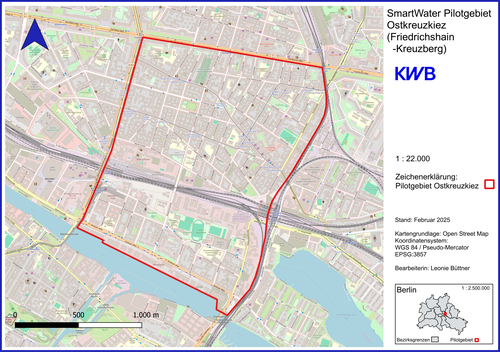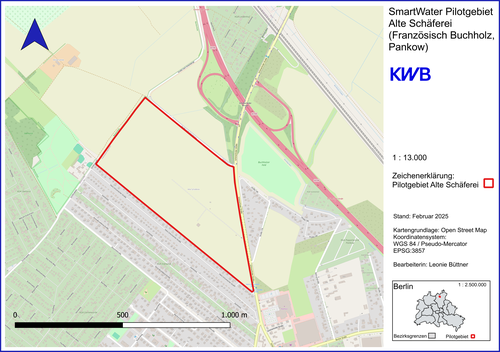Selection of Pilot Areas
Two distinctly different pilot areas have been selected to address the diverse requirements of climate-adaptive urban development. The first is a heterogeneous existing neighbourhood, composed predominantly of older buildings, highlighting the challenges of making changes in a confined space. The second is a planned new residential quarter, still in the early stages of development, with construction set to begin in 2028.

Existing Area: Ostkreuzkiez
- Size: approx. 260 hectares
- Sewage system: Combined system
- Challenges: Triple burden (heat, air pollution, limited green spaces)
- Sealing degree: High
The "Ostkreuzkiez," which includes smaller neighbourhoods like the Boxhagener Kiez, is located in the eastern part of Berlin's Friedrichshain district. It is one of the most densely populated areas in the city. The neighbourhood spans approximately 260 hectares and is bordered by the Spree River to the south, the Ringbahn railway to the east, Frankfurter Allee to the north, and Warschauer Straße to the west.
Characterised by late 19th-century architecture, Ostkreuzkiez is a popular area for historic apartment living. However, during hot summer, the district experiences significant heat build-up, exacerbated by narrow streets and a lack of large green spaces. These so-called urban heat islands pose a severe strain on residents. In addition, the area suffers from poor air quality. More information on these and other environmental factors in Berlin can be found in the Environmental Atlas.

New Development: Alte Schäferei
- Size: approx. 29 hectares
- Residential units: approx. 2,000 (construction starting in 2028)
- Features: Extensive blue-green infrastructure, minimised rainwater runoff, reduced heat stress
- Current project details available on the Pankow Urban Planning website
The "Alte Schäferei" is located in the Pankow district of Französisch Buchholz and is planned to become a vibrant, future-oriented urban quarter. Covering an area of approximately 29 hectares, the site is situated in the northern part of the district, along Hans-Schumacher-Straße and west of Schönerlinder Straße.
The development will include around 2,000 residential units. In addition to much-needed housing, the plan incorporates public green spaces and modern educational facilities. A low-traffic urban design combined with sustainable rainwater management is at the heart of the project's climate strategy. The aim is to create a "sponge city" neighbourhood that minimises new surface sealing, retains rainwater on-site, and promotes infiltration. Measures such as increased greenery and evaporation systems will also help mitigate heat stress in the area.

